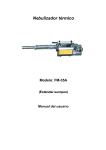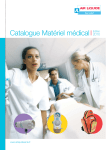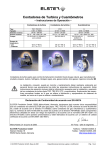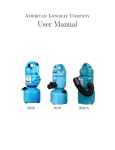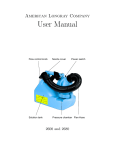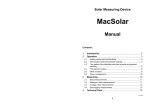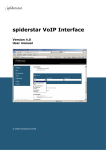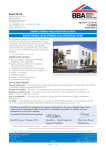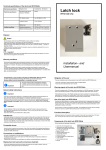Download User Manual - Pestgoaway
Transcript
Longray User Manual gas valve on/off accelerator adjust knob air pump solution tap solution drain solution tank LR-TS75L c 2015 Longray. All rights reserved. fuel tank Contents 1 Warnings 2 2 Warnings for indoor operation 3 3 Tech specs Flow rates . . . . . . . . . . . . . . . . . . . . 4 4 4 Operation First-time setup To start spraying Spraying tips . . To stop spraying 5 5 5 7 8 . . . . . . . . . . . . . . . . 5 Storage . . . . . . . . . . . . . . . . . . . . . . . . . . . . . . . . . . . . . . . . . . . . . . . . 9 6 Troubleshooting 10 Engine does not start . . . . . . . . . . . . . 10 Engine starts, but does not spray fog . . . . . 16 7 Appendix 19 Adjusting the accelerator . . . . . . . . . . . 19 Schematics . . . . . . . . . . . . . . . . . . . 21 1 1 Warnings • After spraying, use water to clean the solution tank and pipeline. This is especially important for corrosive chemicals. • Strongly corrosive chemicals (such as peroxyacetic acid) may damage the unit. Limit to occasional use. • Do not use fogger near flammable surroundings. Never run the unit in the presence of an open flame. • Do not leave a running fogger unattended. • Wear ear protection. • Some components can get hot while spraying. • Let the unit cool down before adding more solution or fuel. Do not transport or pack the unit while it is hot. 2 2 Warnings for indoor operation • In closed spaces, operator should wear a breathing mask. • Some aerosol carriers at high concentrations become flammable. Do not exceed these limits per 1000 m3 . Special carriers Nebal Glyzerine Ekomist Ethylengkole UK2-spezial VK1 Nevolin/nevocol 3.0L 2.5L 2.0L 2.0L 2.0L 1.5L 1.5L Fuels and white oils Vegetable Oil Diesel/Heating Oil Kerosene Petropal Shell Risella 2.5L 2.0L 2.0L 2.0L 1.5L The special carriers volume must be calculated accurately according to the rooms volume. 3 3 Tech specs Exact specifications depend on altitude and temperature. Solution flow rate Solution capacity Solution pressure Fuel engine Fuel consumption Fuel capacity Fuel pressure Fuel type Batteries Dimensions Weight, empty 27 gal/hr 1.3 gal 0.2 bar 25.2 hp 0.4-0.5 gal/hr 0.4 gal 0.1 bar gasoline 4 x 1.5V 51.4 x 11.4 x 14.2 in 23.4 lb Flow rates Exact flow rate depends on carrier viscosity, which depends on temperature. Nozzle diameter (mm) Flow rate (L/h) Flow rate (gal/h) 4 2.0 42 11 3.0 60 15.6 3.5 65 17 4 Operation First-time setup 1. Install 4 x 1.5V batteries into the battery compartment at the base of the nozzle. 2. Shut the gas valve by pressing down. 3. Check the ignition by pumping. You should hear a buzzing sound, “ta ta ta ...” To start spraying 1. Fill the fuel tank using the included fuel funnel. Fill to full capacity. Tip: Tighten the lid lightly, to not damage the rubber seal inside the lid. 2. Fill the solution tank using the included solution funnel. Fill to about two-thirds full. 5 3. Turn the solution tap to the OFF position. off clean 4. Open the gas valve by pulling up. 6 on 5. Gently and slowly push and pull the air pump. 6. Wait 1 minute for the unit to warm up. 7. Clear the area out to 2 meters in front of the nozzle. 8. To start spraying, turn the solution tap to the ON position. Spraying tips Spray behind you as you walk into the wind. Keep nozzle at least 2 meters away from objects. 7 To stop spraying 1. Turn the solution tap to CLEAN position. This releases the solution pressure. off clean on 2. Once the spray dies down, turn the solution tap to OFF. 3. Shut the gas valve by pressing down. 4. Empty the solution tank and rinse with clean water. 8 5 Storage If you will not be using the machine for a while: 1. Rinse the solution tank using clean water. 2. Rinse the solution feed using clean water. 3. Remove the batteries. 9 6 Troubleshooting Engine does not start 1. Check fuel tank level. Ensure it is 1/3 to 2/3 full. 2. Check ignition system. Remove the ignition cap and press the cap to the metal body. Without touching the metal body, start pumping. If you can hear a sound like “Ta Ta Ta”, then the ignition system is functioning properly. Otherwise, replace the batteries. 3. Clean the air intake. Take apart the air intake assembly in the back of the machine. Clean the spacer plates. Use a soft cloth to wipe the diaphragm. The engine will not start if the diaphragm is wet. 10 4. If the diaphragm was dry, skip to the next step. If the diaphragm was wet, decrease the accelerator setting. See Appendix. Through trial and error, find a setting that is low enough that the diaphragm isn’t wetted during startup, but not so low that the engine won’t start. You will need to dry the diaphragm in between tests. 5. Check and clean swirl pole. Unscrew the swirl pole. Check that the two needles at the end of the swirl pole are clean, sharp-edged, and symmetrical: 11 1 2 3 4 6. Check one-way diaphragm for fitting/damage. Detach the rubber tube from the diaphragm. Inspect the diaphragm. 12 Good Bad Do not re-screw the one-way diaphragm too tightly. 7. Check pump seal for fitting/damage. 8. Check large rubber O-ring for fitting/damage. 13 9. Clean fogging tube. Remove any deposited carbon. 10. Check gas injection. Remove ignition voltage cap, two screws, and the swirl pole.. 14 Insert finger into the swirl pole cavity, and begin pumping. Increase the accelerator setting until you can feel the gas spray. 15 Engine starts, but does not spray fog 1. Check solution tank pressure. With the engine running and the solution tap in the ON position, remove the solution lid and place your palm over the opening. If you can feel pressure, contact technical support. If there is no pressure, continue to the next step. 2. Clean the solution line. Remove and clean the connecting screw. 16 3. Check the one-way diaphragm. Detach the rubber tube from the diaphragm. Inspect the diaphragm. Good Bad 4. Clean the solution filter. 17 5. Clean the nozzle. Wait for fogging tube to cool. Carefully unscrew the nozzle. Clean out any clogs. 18 7 Appendix Adjusting the accelerator The notch at the top of the dial points to the current setting, here ”0”. The higher the setting, the higher the gas feed rate. • Do not use a setting above 4 unless specifically instructed. • While adjusting, stay at least 2 meters away from the front of the unit. If the accelerator is too low, the engine may not start. The accelerator is too high if: 19 • You can hear the engine pop noise as you pump the machine, or • Gas wets the diaphragm. 20 Schematics (Page intentionally left blank.) 21 22 23 TS-75L 2 143 146 144 145 134 135 133 123 124 54 132 125 126 73 127 129 74 128 75 130 78 77 76 95 96 97 98 99 79 82 83 88 87 84 86 81 6 80 6 69 72 70 71 85 24 73 74 75 72 142 143 141 140 139 138 137 136 110 109 112 115 114 113 116 118 117 120 121 107 119 106 90 122 105 91 104 103 92 54-60 93 102 101 95 100 96 97 98 99 67 66 68 69 70 71 25 94 108


























